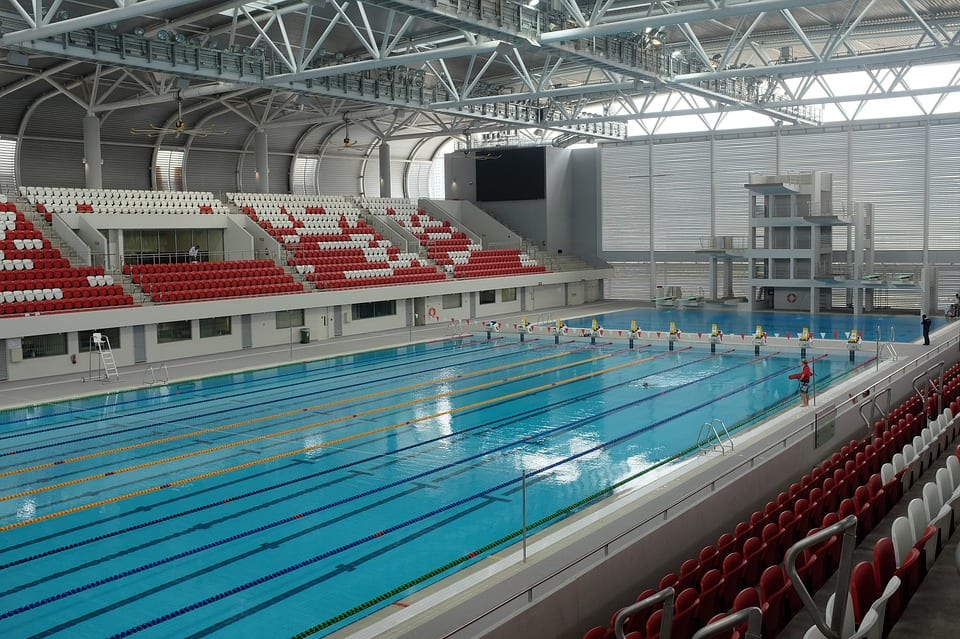Finding Fitness is more than just about scoping out the latest fitness trends; it’s about finding exciting new ways to focus on the most important subject of any story: you. From extreme sports to strange and, sometimes, uncomfortable classes, this feature is all about finding the best fitness to maximize your health. Stay tuned to find out what new and exciting fitness endeavors are in the area.
What is water aerobics?
Water aerobics is basically any type of aerobic workout exercise, such as running, pushups or jumping, that is done in the water, according to Lesley Shahan, who has taught water aerobics for five years at the Pompano Beach Aquatics Center.
Nancy Bernreuter, group exercise instructor at RecWell, said, “It is a cardiovascular strength training class that consists of cardio and strength and provides people with a really good workout, but it’s much easier on your joints. It can be really advanced or easy, depending on how you move through the water.”
There are two different aspects of water aerobics: cardio and strength training. The cardio aspect of water aerobics includes running, jumping and different stretching movements. Strength training in water aerobics includes the use of special plastic or foam weights in the water.
Not all water aerobics courses are the same, and there are many forms of water aerobics to choose from. Shahan teaches both high intensity and mild forms of water aerobics. High intensity classes focus on cardio and are specially designed to burn a large amount of calories to aid in weight loss.
Mild forms of water aerobics are less of a workout and focus more on stretching, which is ideal for those recovering from injuries, the elderly and the disabled. Bernreuter typically teaches Aqua Bootcamp, which features a mixture of cardio and strength training throughout the course.
However, there are many other options when it comes to water aerobics courses.
“There are yoga classes in the water, boxing classes, and there’s actually even water Zumba,” said Bernreuter.
There is even a course called Hydrocycle, which is a spinning course in the water.
Bernreuter, who is also certified to teach Hydrocycle, said, “It’s essentially bikes in the water; instead of spinning on land, it’s done in the water. It’s something totally different. Because of the resistance in the water, it’s actually 12 times harder than it would be on land.”
Shahan said that water aerobics is a unique form of exercise because it is one of the few formal exercises that makes use of the low impact nature of water.
“I think it’s unique because, firstly, it’s done in the water,” she said. “Not many sports or physical activities aside from swimming are done in the water; they’re done outside. If you run on a treadmill or jump up and down on the ground, that’s very bad for your joints, like your knees and ankles. But doing it in the water is less of a risk for injury — you’re not going to injure yourself, and you can take it at your own pace.”
What are the benefits?
Due to the various types of water aerobics classes, there are multiple health benefits that this exercise has to offer. It has all of the benefits of typical cardio and strength workouts, but it is easier in the body. Water aerobics is ideal for individuals who may not be able to exercise efficiently on land while carrying their full body weight.
Shahan said, “Elderly people or those who are overweight may have trouble running or lifting weights, so anything they can’t do outside of the water becomes possible in the water. It’s very low impact, it’s done at your own pace, and it basically can help anyone stretch, workout, get stronger or lose weight.”
Both Shahan and Bernreuter said that water aerobics has great benefits for individuals who suffer from arthritis.
“The non-gravity in the water cancels out 90 percent of your body weight, so there’s no impact in the water,” said Bernreuter. “So it’s perfect for people with joint injuries. The Arthritis Foundation also has a whole program that runs in the water to help people with joint issues.”
What are the risks?
According to Bernreuter, there are no documented health risks associated with water aerobics.
However, Shahan, who is a certified lifeguard, notes that there minimal health risks that are associated with the environment that water aerobics classes can be taken in.
Shahan said, “There are very minimal, common ones, such as sun exposure if you’re outside. You could cramp up, and that could trigger asthma, which can be a little more dangerous since you are in the water, but, other than that, it’s a very low-risk course for people to take.”
Water aerobics is an appropriate workout for anyone, regardless of their level of fitness.
“I think water aerobics is pretty much good for everyone,” Shahan said. “If people don’t know how to swim, that’s OK because it’s done in the shallow end, and there are always lifeguards on duty. Even for those who can’t walk, there are ways to get them into the pool.”
Bernreuter also encourages people who are interested in a new type of workout to try water aerobics.
She said, “I encourage everyone to try it because a lot of people have a misconception about it. They think because it’s in the water that it’s just for the elderly, but it’s quite the opposite. So I would encourage people to keep an open mind and try it.”
Places to take water aerobics courses:
Recreation and Wellness Center
Nova Southeastern University
3300 S. University Drive, Fort Lauderdale-Davie
Visit rec.nova.edu/fitness/ for a schedule of classes once they resume.
Pine Island Aquatic Center
3800 SW 92nd Ave., Davie
Classes are held on weekday mornings and evenings as well as on Saturdays.
Plantation Aquatic Center
9151 NW Second Street, Plantation
Call 954-452-2525 for schedule of classes.
LA Fitness
3500 N. University Dr., Sunrise
Visit lafitness.com/Pages/ClassSchedulePrintVersion.aspx?clubid=113 for a schedule of classes.
Photo credit: pixabay.com


